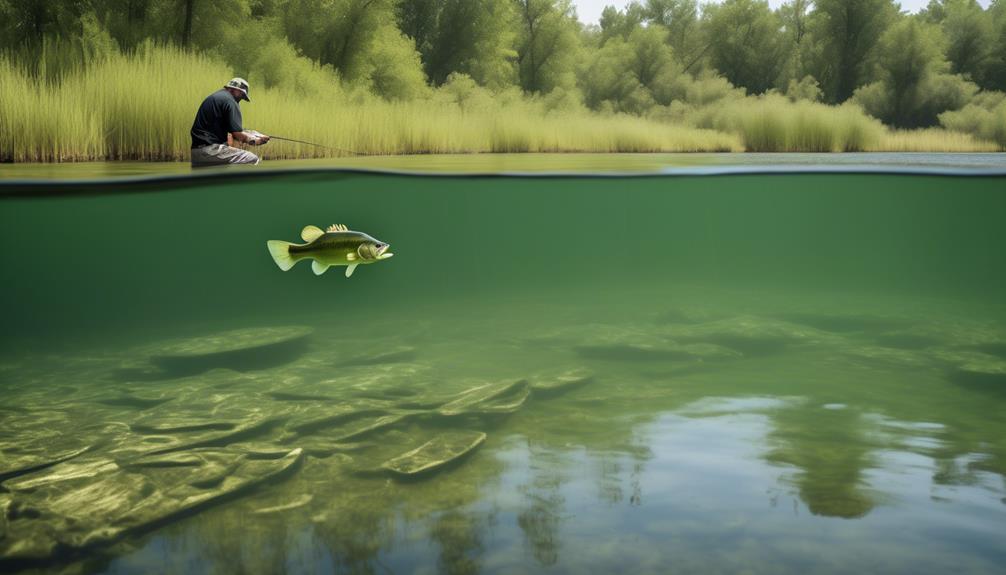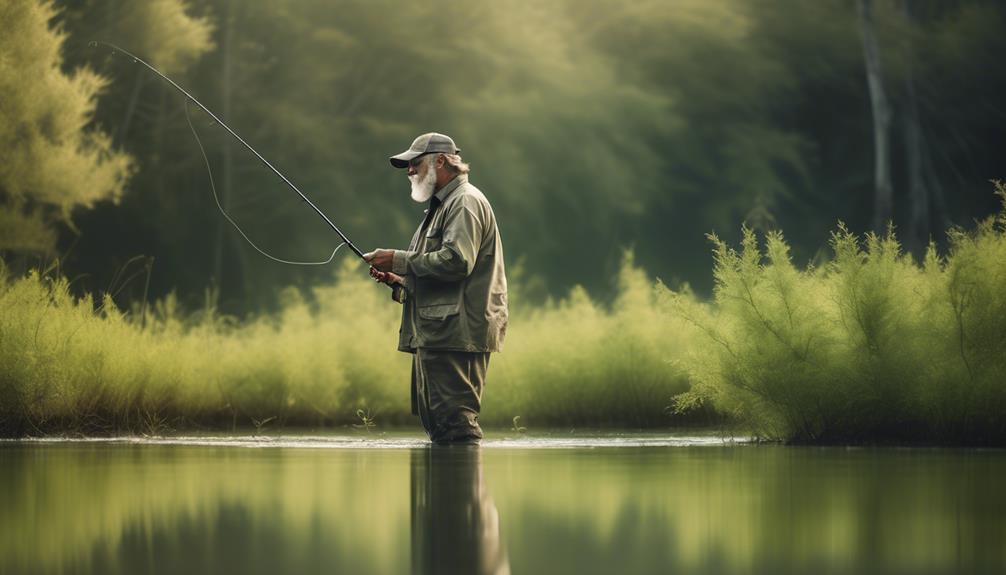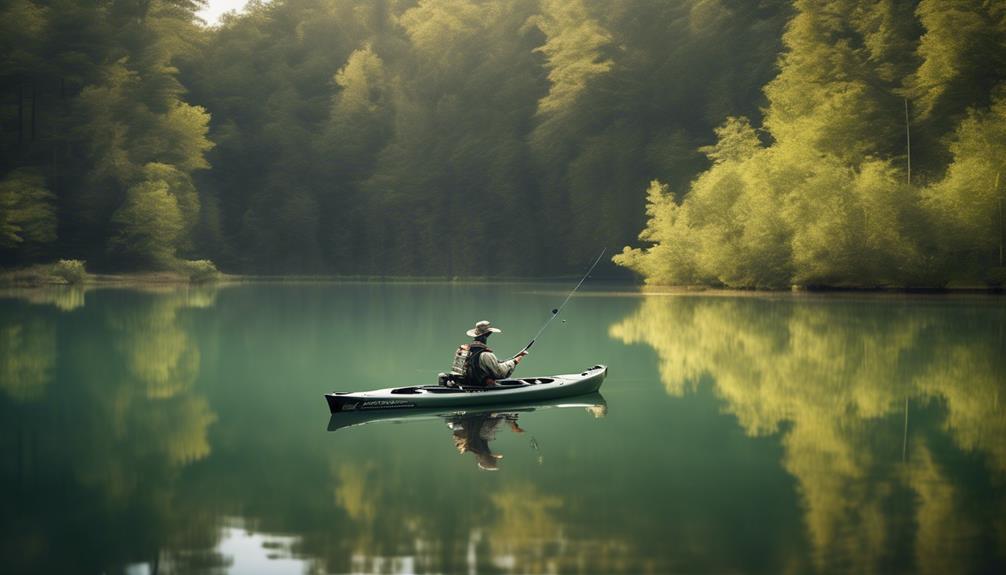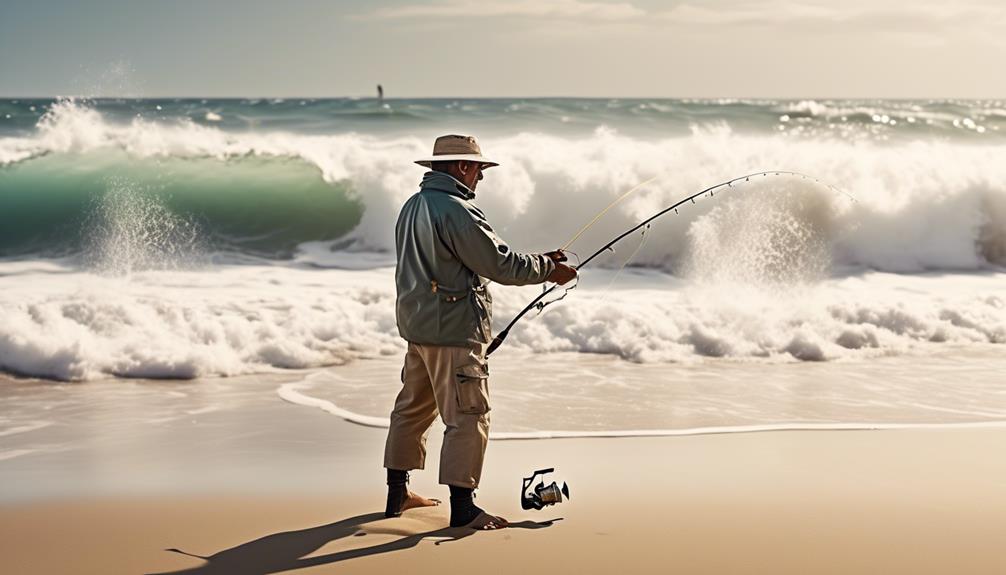Ever wondered if there's a secret to consistently catching bass in shallow water? You may have heard various theories and techniques, but how do you separate the myths from the tried-and-true methods? Understanding the behavior of bass in shallow water is crucial, and knowing the best techniques can make all the difference in your success.
Whether you're an experienced angler looking to refine your skills or a novice eager to learn, this discussion will uncover the most effective strategies for targeting bass in shallow water. So, let's dive in and explore the world of shallow water bass fishing together.
Understanding Shallow Water Bass Behavior

To effectively catch bass in shallow water, you need to understand their behavior and feeding habits. Bass are often found in shallow water during the spring and fall, seeking out warmer temperatures and abundant food sources. During these seasons, they tend to be more active and are more likely to be found in the shallows. Understanding the behavior of bass in shallow water is crucial for a successful fishing trip.
Bass in shallow water are often in search of food. They're opportunistic feeders and will often be found near cover such as rocks, fallen trees, or vegetation where they can ambush their prey. By understanding this behavior, you can strategically place your bait near these areas to increase your chances of getting a bite.
In addition to feeding habits, it's important to consider the impact of environmental factors on bass behavior in shallow water. Factors such as water temperature, weather conditions, and time of day can all influence where the bass are located and how they're behaving. For example, on sunny days, bass may seek shade under docks or overhanging vegetation, while on overcast days, they may roam more freely in the shallow waters.
Selecting the Right Lures for Shallow Water Bass
Understanding the behavior of bass in shallow water can help you select the right lures to increase your chances of a successful catch. When choosing lures for shallow water bass fishing, it's important to consider the water clarity and the type of cover or structure present. Here's a breakdown to help you select the most suitable lures:
- Topwater Lures:
- Buzzbaits: Effective in low light conditions or when bass are actively feeding near the surface.
- Frogs: Ideal for areas with thick vegetation or lily pads where bass might be lurking.
- Diving and Crankbaits:
- Shallow Diving Crankbaits: Perfect for targeting bass in water depths of 1 to 5 feet, especially around rocky areas or submerged timber.
Selecting the right lures is crucial for enticing bass in shallow water. Topwater lures like buzzbaits are excellent choices for early morning or late evening fishing when bass are likely to be feeding near the surface. Additionally, using frogs in areas with heavy vegetation can mimic natural prey, making it an attractive option for shallow water bass fishing. Furthermore, shallow diving crankbaits are effective for covering a lot of water and can be used around shallow cover like rocks and timber where bass tend to hide.
Mastering the Art of Flipping and Pitching

Mastering the art of flipping and pitching requires precise casting techniques and a thorough understanding of your target's behavior in shallow water. When it comes to flipping, the key is to make short, accurate casts to specific targets such as submerged logs, boat docks, or overhanging vegetation. To execute a successful flip, start by releasing the lure about halfway through the forward motion of your cast. This allows for a controlled descent of the bait, giving you the chance to entice a strike from lurking bass.
Pitching, on the other hand, involves longer casts with a more pronounced underhand motion. This technique is ideal for reaching targets slightly farther away, like isolated cover or brush piles. As you pitch your bait, focus on maintaining a quiet entry into the water to avoid spooking any nearby bass.
To excel at flipping and pitching, it's crucial to develop a sense of accuracy and control. Practice your casts to hone in on your ability to place your lure exactly where you want it. Additionally, pay close attention to the movement and behavior of bass in shallow water. Understanding their tendencies and preferred hiding spots will greatly increase your success when employing these techniques.
Ultimately, mastering flipping and pitching takes time and dedication, but once you've honed these skills, you'll have a powerful set of techniques for targeting bass in shallow water.
Perfecting Topwater Techniques for Shallow Water
Perfect your topwater techniques for shallow water by experimenting with various surface lures and observing bass behavior in different water and weather conditions. When fishing in shallow water, especially during the early morning or late evening when bass are most active near the surface, mastering topwater techniques can significantly increase your chances of a successful catch.
Here are some tips to help you perfect your topwater techniques:
- Choose the Right Lure:
Experiment with different types of topwater lures such as poppers, walkers, and buzzbaits to determine which ones are most effective in shallow water. Vary the size, color, and action of the lures to see what attracts bass in different conditions.
- Observe Bass Behavior:
Pay close attention to how bass react to your topwater lures. Are they hesitant or aggressive? Do they strike immediately or follow the lure before committing? Understanding bass behavior in response to your lures can help you adjust your technique for better results.
Navigating Vegetation and Structure in Shallow Water

Navigating vegetation and structure in shallow water requires a keen understanding of how bass interact with their environment and an adept ability to adapt your techniques to the unique challenges presented by these features. When it comes to vegetation, such as lily pads, hydrilla, or fallen trees, bass often seek shelter and ambush points within these areas. To navigate these structures effectively, consider using weedless lures like Texas-rigged soft plastics or topwater frogs to avoid getting snagged. When casting into these areas, aim for the openings or edges where bass are likely to be waiting for prey.
In addition to vegetation, shallow water often contains various structures such as submerged rocks, stumps, or docks. These structures serve as prime feeding and resting spots for bass. To navigate these areas, precision casting is crucial. Use techniques like skipping or pitching to get your lure into tight spaces and enticing those bass hiding within the structure. Furthermore, consider using jigs or crankbaits that can effectively penetrate the cover without getting hung up.
It's important to approach these areas stealthily, as any disturbance can spook the bass. Slow and deliberate movements will help you navigate through the vegetation and structure without alerting the bass to your presence. By mastering these techniques, you can effectively navigate the challenges of vegetation and structure in shallow water, increasing your chances of landing that prized bass.
Implementing Effective Sight Fishing Strategies
When sight fishing in shallow water for bass, it's essential to focus on spotting the fish before making your cast. This technique requires patience and a keen eye to identify the fish lurking in the shallows.
To effectively implement sight fishing strategies, consider the following:
- Positioning:
Position yourself at an elevated vantage point if possible, such as on a boat platform or the shoreline, to enhance your visibility into the water. This will help you spot bass more easily as they move through the shallows.
- Observation:
Take your time to scan the water and look for subtle movements, shadows, or flashes of color. Bass may blend in with their surroundings, so a keen eye is crucial for spotting them. Look for any signs of bedding activity, such as circular depressions in the sand or gravel.
Once you've spotted a bass, carefully plan your approach. Make slow and deliberate movements to avoid spooking the fish. Choose your bait wisely, opting for lures that resemble the natural prey in the bass's environment. When casting, aim to place your lure accurately in the bass's line of sight, enticing it to strike.
Embracing the Benefits of Kayak Bass Fishing

Embracing the Benefits of Kayak Bass Fishing allows you to apply your keen eye and strategic approach from sight fishing in shallow water to a new and exciting setting. Kayak fishing offers numerous advantages for bass anglers.
One of the key benefits is the ability to access fishing spots that are off-limits to traditional boats. With a kayak, you can navigate through narrow channels, weed-choked areas, and shallow flats where bass tend to congregate. This gives you a competitive edge by reaching untouched fishing grounds.
Furthermore, kayaks provide a stealthy approach, allowing you to sneak up on wary bass without disturbing them. This is particularly advantageous in shallow water, where any disturbance can spook the fish. Being closer to the water also enhances your connection with the environment, making it easier to spot subtle movements and changes in the water that could indicate the presence of bass.
Additionally, kayak bass fishing promotes physical fitness. Paddling a kayak requires core strength and stamina, providing a full-body workout while you pursue your passion for bass fishing. Moreover, kayaks are more economical and easier to maintain than larger boats, offering cost-effective access to prime fishing locations.
Frequently Asked Questions
What Are the Best Types of Boats for Shallow Water Bass Fishing?
When shallow water bass fishing, the best types of boats are flat-bottomed or pontoon boats. These boats have shallow drafts, allowing you to navigate through shallow waters more easily and access prime fishing spots.
How Can I Effectively Use Live Bait in Shallow Water Bass Fishing?
To effectively use live bait in shallow water bass fishing, cast your bait near cover and wait for a bite. Keep your line tight and be ready to set the hook when you feel a strike.
Are There Specific Weather Conditions That Are Better for Shallow Water Bass Fishing?
In shallow water bass fishing, specific weather conditions can greatly impact success. Look for overcast days or early morning/evening hours when bass are more active. Wind can also create ripples, making it easier to approach without spooking them.
What Are Some Tips for Finding the Best Spots for Shallow Water Bass Fishing?
To find the best spots for shallow water bass fishing, look for areas with vegetation, like lily pads or submerged grass. Also, pay attention to structures like docks, fallen trees, and rocks, as they provide cover for bass.
What Are the Best Ways to Handle and Release Bass in Shallow Water to Ensure Their Survival?
When handling and releasing bass in shallow water, gently support their body, avoid squeezing, and minimize air exposure. Keep them in the water and release when they can swim away strongly. This helps ensure their survival.
Conclusion
So, now you know the best techniques for shallow water bass fishing.
By understanding bass behavior, selecting the right lures, mastering flipping and pitching, perfecting topwater techniques, navigating vegetation and structure, implementing sight fishing strategies, and embracing kayak fishing, you'll have the skills to reel in those elusive bass.
Get out there and put these techniques to the test, and you'll be sure to have a successful day on the water.
Happy fishing!



